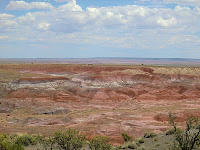
Currently this portion of Arizona is a dry grasslands but about 200 million years ago during the late Triassic period it was a humid, tropical, vast floodplain that had many streams crossing it. Tall conifer trees grew along the banks would fall and the streams would wash them into the floodplains. A mix of silt, mud, and volcanic ash buried the logs. The sediment cut off oxygen and slowed the logs' decay. Over time silica-rich groundwater seeped through the logs, replacing the original wood tissues with silica deposits. Eventually the silica crystallized into quartz and the logs were preserved as petrified wood.

At the southern end of Petrified Forest National Park is a short Giant Logs Trail. Normally they say the 0.3 mile loop should take 20 minutes but I think we did it in 10 because of the heat. Still, we saw wonderful, colorful petrified wood deposits in the Chinle Formation. The colors of the logs are due to trace minerals that soaked into the wood along with the silica. Blue, purple, brown and black are caused by manganese minerals.

As you drive north along the park road you are driving toward younger deposits. At the farthest north, at Chinde Point on the Painted Desert portion of the park, the rocks are about 205 million years old. Over 10 million years of deposition occurred within the park. The views of the Painted Desert were remarkable. Next time I'd like to visit during the spring or fall when it isn't so hot!









No comments:
Post a Comment